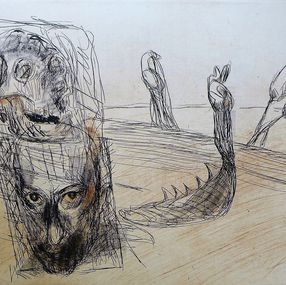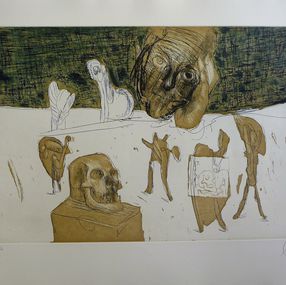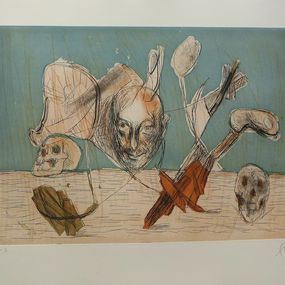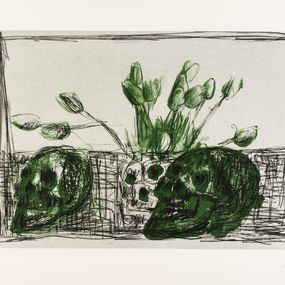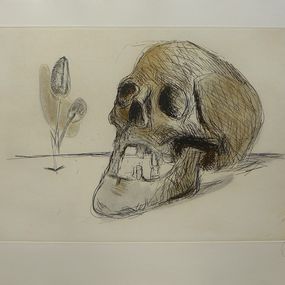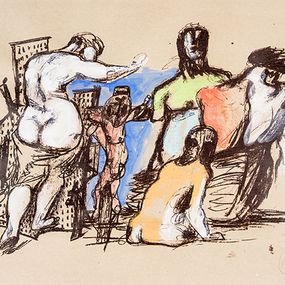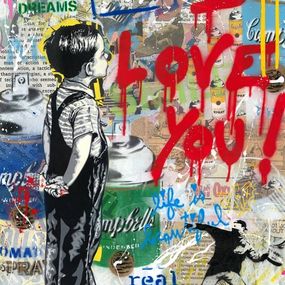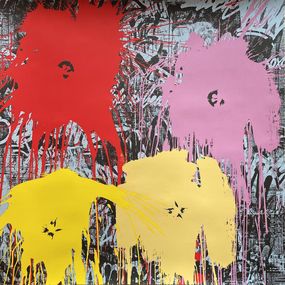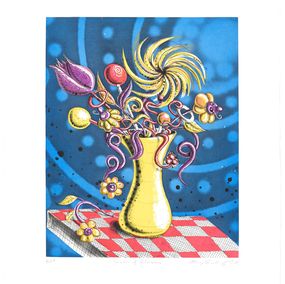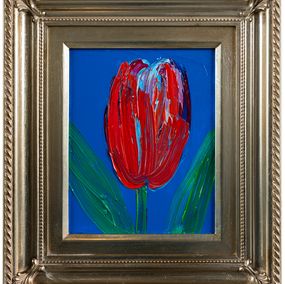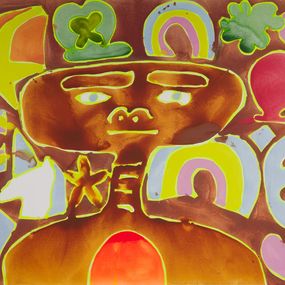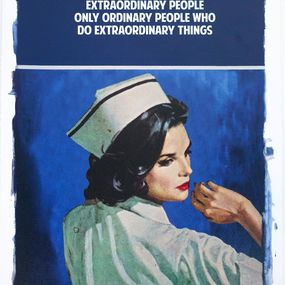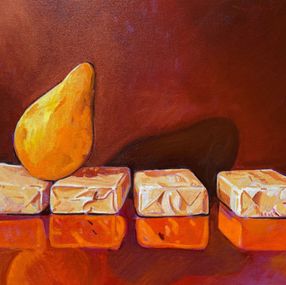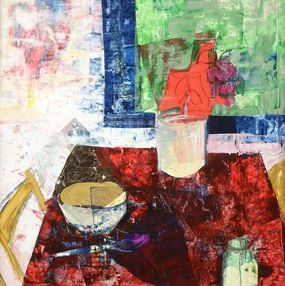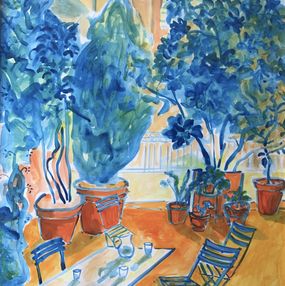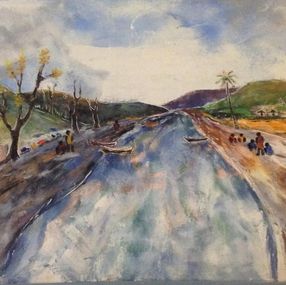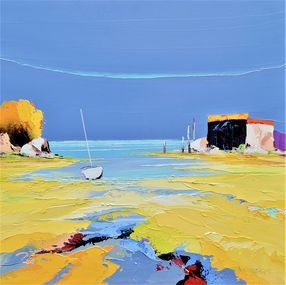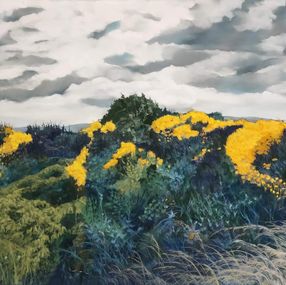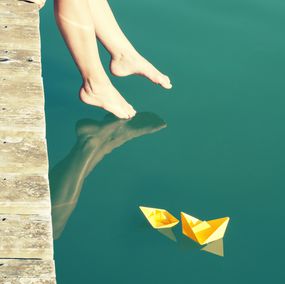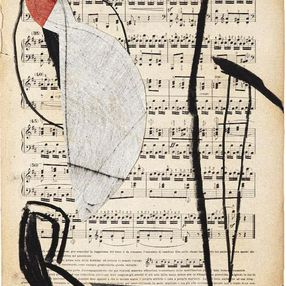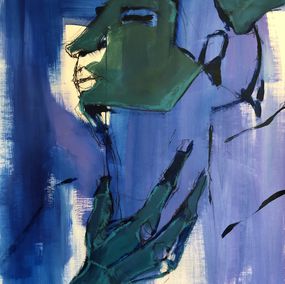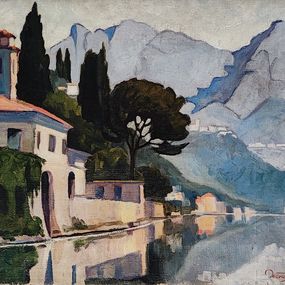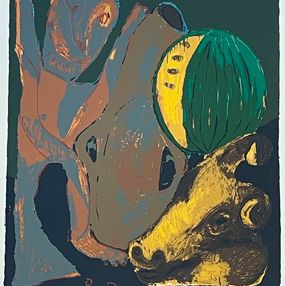
by Markus Lüpertz
Sculpture : bronze
45 x 20 x 20 cm 17.7 x 7.9 x 7.9 inch
Second NOT DISPLAYED BLUR TEXT
Free returns within 14 days
Authenticity guaranteed
Learn moreSecure payment
About the artwork
Type
Numbered and limited to 10 copies
1 copy available
Signature
Hand-signed by artist
Authenticity
Sold with certificate of Authenticity from the gallery
Invoice from the gallery
Medium
Sculpture: bronze
Dimensions cm • inch
45 x 20 x 20 cm 17.7 x 7.9 x 7.9 inch Height x Width x Depth
Display
The sculpture cannot be displayed outdoors
Tags
Artwork sold in perfect condition
Artwork location: Germany
Markus Lüpertz’ bronze sculpture “The Eleven and the Dancing Bear” is based on a graphic from 1881 by the artist Max Klinger. Max Klinger was a German sculptor, painter and graphic artist whose work is primarily associated with Symbolism.
Markus Lüpertz’s bronze sculpture, is a mesmerizing testament to the artist’s profound exploration of mythological themes and the human condition. Crafted with masterful precision and imbued with symbolic depth, this sculpture captivates viewers with its enigmatic narrative and dynamic composition.
Standing tall and proud, the figure of the elf exudes an otherworldly aura, evoking the timeless archetype of the mystical forest dweller. With elongated limbs and a graceful stance, the elf exudes a sense of ethereal grace, as if poised between the realms of reality and fantasy. Adorned with intricate details, from flowing robes to delicate facial features, the sculpture invites closer inspection, revealing layers of meaning beneath its surface beauty.
At the elf’s feet, the dancing bear adds a whimsical yet profound element to the composition. Symbolizing strength, vitality, and untamed nature, the bear embodies primal instincts and raw energy. Its joyful dance captures a moment of pure exuberance, inviting viewers to embrace the joy and spontaneity of life. Yet, beneath the surface, there is a deeper resonance to this pairing of elf and bear, hinting at themes of harmony, balance, and the interplay between civilization and the wilderness.
Through “Elf and the Dancing Bear,” Lüpertz invites viewers on a journey into the realm of myth and imagination. Drawing upon ancient legends and archetypal imagery, the sculpture speaks to universal truths and eternal mysteries. With its timeless beauty and rich symbolism, it serves as a poignant reminder of the enduring power of art to inspire, provoke, and enchant.
In art, the symbolism of an elf paired with a dancing bear carries profound and multifaceted meanings that resonate across cultures and epochs. At the heart of this symbolic union lies a rich tapestry of themes ranging from nature’s majesty to spiritual transcendence, from harmonious balance to narrative allegory.
Central to this imagery is the dichotomy between civilization and the untamed wilderness, embodied respectively by the elf and the dancing bear. The elf, steeped in folklore and myth, represents humanity’s connection to the natural world, often depicted as a guardian of forests and a conduit to mystical realms. In contrast, the dancing bear symbolizes the primal forces of nature, exuding strength, vitality, and an unbridled energy that speaks to the raw essence of existence.
Yet, within this apparent dichotomy lies a deeper truth of complementary forces converging in harmony. The graceful presence of the elf, with its ethereal beauty and otherworldly aura, finds balance in the exuberant dance of the bear, whose joyous movements echo the rhythmic cadence of life itself. Together, they embody a symbiotic relationship between humanity and nature, suggesting a profound interconnectedness that transcends the boundaries of species and civilizations.
Moreover, the pairing of an elf and a dancing bear invites contemplation of broader thematic narratives. Through allegory and symbolism, artists weave tales of friendship, cooperation, and resilience, inviting viewers to embark on a journey of exploration and discovery. Each viewing becomes an opportunity to unravel the layers of meaning within the artwork, to find resonance with personal experiences, and to glimpse the universal truths that lie at the heart of human existence.
In essence, “Elf and the Dancing Bear” and artworks of its ilk serve as portals to the collective imagination, inviting us to ponder the mysteries of life, the wonders of nature, and the timeless dance of existence. Through their symbolic imagery and evocative narratives, they inspire us to embrace the beauty of diversity, the harmony of opposites, and the boundless possibilities of the human spirit.
Markus Lüpertz, a prominent German artist known for his neo-expressionist style, and Max Klinger, a German symbolist painter and sculptor from the late 19th and early 20th centuries, may not have had a direct personal connection, as they lived in different time periods. However, their artistic legacies and perhaps thematic similarities might draw comparisons or influence.
Klinger was a significant figure in the Symbolist movement, which sought to express abstract or spiritual ideas through art. He was known for his use of symbolism and mythological themes, often exploring the subconscious and fantastical realms in his work. One of his most famous works is the series of etchings titled “Paraphrase on the Finding of a Glove,” which tells a story through symbolic imagery.
Lüpertz, on the other hand, emerged as a leading figure in the German neo-expressionist movement of the late 20th century. His paintings are characterized by bold, gestural brushwork and often incorporate mythological or historical motifs. Lüpertz’s work reflects a fascination with Germanic mythology and a desire to engage with the grand tradition of Western art.
While there may not be a direct connection between the two artists, Lüpertz’s interest in mythology and symbolism could be seen as a continuation or reinterpretation of themes explored by Klinger and other Symbolist artists. Both artists share an interest in using art to convey deeper meanings and explore the human experience, albeit in different historical and cultural contexts.
About the seller
FRANK FLUEGEL GALERIE • Germany
Artsper seller since 2014
Vetted Seller
Top Seller
This seller rewards your purchases of multiple artworks
Discover more by the artist
Works in prints from Markus Lüpertz
Presentation
When he was seven years old, Markus Lüpertz came with his family to Germany. From 1956 to 1963 he studied in the class of Laurens Goosens at the art school in Krefeld and at the Academy of Arts in Düsseldorf. In 1962 Lüpertz moved to West Berlin, where he founded the self-help gallery 'Großgörschen 35' with Bernd Koberling and Karl Horst Hödicke.
Markus Lüpertz started to paint pictures with simple representational contents against all contemporary tendencies towards abstraction. In a manifesto of 1966, he titled his emphatically expressive pictures 'dithyrambische Malerei' - after an ancient Greek ritual song for the fertility god Dionysos. In the years 1969 until 1977 he created the 'German motives' - picture compositions in the form of still lives that present symbolic objects of the past such as steel helmets, shovels or flags in monstrous dimensions and demand to come to terms with German history.
In 1970 Lüpertz received the prize of the Villa Romana and spent the year of his scholarship in Florence. In 1976 he accepted a chair at the academy in Karlsruhe. Since 1977 he took up abstract tendencies of the 1950s in his 'Stil-Bildern'. In the same year the Kunsthalle in Hamburg presented a first survey of his oeuvre, followed by the Kunsthalle in Bern and the Stedelijk Van Abbe museum in Eindhoven. He gave up the increasing abstraction in his pictures in favour of a new representational and three-dimensional style, in which he applied art-historical quotations and style elements. Lüpertz uses all printing techniques, works as a poet and, since 1980, as a sculptor and stage designer.
In 1982 he took part at the documenta VII in Kassel. In 1986 he was offered a chair at the Academy of Arts in Düsseldorf, which he heads as principal since 1988. Lüpertz received the Lovis-Corinth prize of the artist guild Esslingen in 1990. Important individual exhibitions were dedicated to his oeuvre. A work show arranged according to subject was organized at the Art Collection North-Rhine-Westphalia in Düsseldorf in 1996 and a retrospective exhibition at the Kunsthalle of the Hypo-Culture Foundation in Munich in 1997, which was later presented in Wuppertal and Barmen. In 1997/98 his works were represented at the exhibition "Deutschlandbilder: Kunst aus einem geteilten Land" in the Martin-Gropius building in Berlin.
More works from FRANK FLUEGEL GALERIE
This seller offers discount when you purchase multiple artworks!
Protect your purchase
We’re here to help you collect art securely. When you browse and buy on Artsper, you benefit from our guaranteed protections.
Buy works from the best galleries
We partner with the best art galleries. All sellers on Artsper have been carefully reviewed and approved by our team. All of our partner galleries respect our code of ethics.
Know what you’re getting
Each work on Artsper is studied and validated by our team before appearing online. Get personalized support Contemporary art specialists are available by phone and email to answer all of your questions about our works of art. Get personalized advice and curated suggestions for your collection.
Resell your artworks
As a private individual, you have the possibility to resell on Artsper your works acquired on Artsper. For more information click here.
Make an offer with Artsper
Negotiate prices
Price negotiation is possible. Like in a gallery, this allows you to open a discussion and purchase your works at your preferred price.
Get our help negotiating
Let our team handle the negotiations and get back to you once the best deal is made.
Order safely
Artsper’s satisfaction guarantee
With Artsper, you have the opportunity to return a work free of charge within 14 days of receipt if it does not suit you, for whatever reason. You will then receive a full refund for your order.
Protect your purchase with Artsper’s payment partners
All credit card payments are processed by Paybox, the trusted leader in payment processing for international businesses. Paybox ensures the highest level of security.
Get specialized support from Artsper in the event of a problem
On the rare occasion that a work of art arrives in a different condition than described, we will work to administer a return, refund, restoration or exchange for you. Our team will always keep you informed on the progress of your request and will go above and beyond to offer you personalized solutions.
To benefit from Artsper’s protections you must:
-
Place your order using one of Artsper's payment methods.
-
Report any issues to Artsper within one week of receiving your work.
-
Provide all requested photographic evidence of the problem (including the original artwork and packaging).
Artsper’s guarantee covers the following problems:
-
You receive a work that’s missing a described characteristic (such as a signature or a frame)
-
You receive a work with different characteristics than those described at the time of purchase
-
You receive a damaged piece of work
-
Your purchase is declared lost or damaged during transit
-
You receive a work that is a different in color than what you ordered
-
Your purchase is delayed
Artsper gives you access to the largest catalog of contemporary artworks, from the best galleries (200,000 works, 25,000 artists, 2,000 partner galleries).
We select the galleries with which we collaborate. This demanding selection, operated by our team of experts, offers you several guarantees:
- Double expertise regarding the quality and originality of the works. On the one hand by professional galleries that select their artists and works. On the other hand by Artsper which selects its partner galleries according to the quality of their catalog and their reputation.
- Access to the entire catalog of works from our partner galleries, sold at the same price as in the gallery.
- The possibility of returning purchased works (within 14 days) if they do not suit you, wherever you are in the world. Which is not the case outside Artsper.
- The possibility of easily reselling the work you purchased on Artsper.
We also facilitate the search for works according to your preferences thanks to our intelligent features such as:
- Your custom selection, created based on your tastes;
- Your custom universe, choose from our different universes the one that suits you and access selections of works!
Or simply thanks to our filters on the catalog allowing you to refine your searches.
Our customer service is also at your service and responds within the shortest time!
For some artworks, you can negotiate the price. If the price of the work is negotiable, you have a “Make an offer” button under the “Buy this work” one.
To submit your offer, you must make a payment of the desired amount. Your offer will then be forwarded to the gallery, which reserves the right to accept or reject it. If your offer is accepted, it means that your order is confirmed by the gallery and they will prepare the artwork for shipment. If your offer is rejected, you will be refunded the total amount paid automatically. The gallery can also propose a counter-offer for the acquisition of the artwork.
If you have any questions, please feel free to contact us: [email protected].
Artsper delivers worldwide!
However, please note that once your order reaches its destination, it may be subject to VAT or other customs fees. These charges are beyond our control and you will be responsible for paying them (this is indicated at the ‘checkout’ first step).
Select the delivery address of your choice. Please make sure that someone is present to receive your order.
If your billing address is different to your delivery address you can specify this at the checkout.
You can return the artwork without needing to provide a reason or pay a penalty fee up to 14 days after receiving your order.
In the case that the right of withdrawal is exercised in the aforementioned time frame, the price of the artwork(s) purchased and the shipping costs will be reimbursed by us as soon as the gallery has received the artwork and notified us.
Artsper will manage the return of the work and will bear the cost of returns (which will either be paid by you and refunded by Artsper or directly paid by Artsper).
The artwork must be returned in perfect condition and in its original packaging (or equivalent).
The buyer exercises his right of withdrawal directly from MUMART, by sending an email to the address: [email protected].
If you have bought a painting, a sculpture or a work on paper, find expert advice on its conservation and how to best enhace it:




